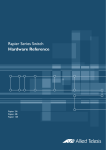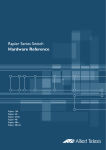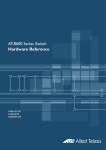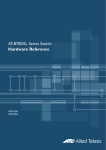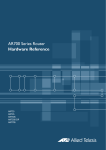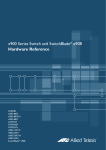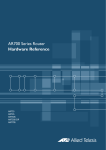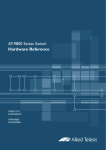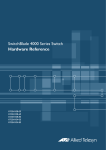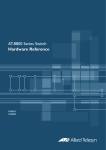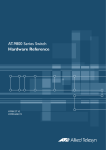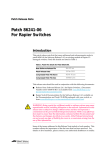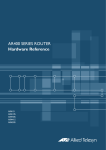Download Allied Telesis Rapier 16F-FX/MT Specifications
Transcript
Rapier Series Switch Hardware Reference Rapier 16fi Rapier 24i Rapier 48i Rapier 48w Rapier Series Switch Hardware Reference Document Number C613-03020-00 REV K © 1999-2007 Allied Telesis, Inc. All rights reserved. No part of this publication may be reproduced without prior written permission from Allied Telesis, Inc. Allied Telesis, Inc. reserves the right to change specifications and other information in this document without prior written notice. The information provided herein is subject to change without notice. In no event shall Allied Telesis, Inc. be liable for any incidental, special, indirect, or consequential damages whatsoever, including but not limited to lost profits, arising out of or related to this manual or the information contained herein, even if Allied Telesis, Inc. has been advised of, known, or should have known, the possibility of such damages. All company names, logos, and product designs that are trademarks or registered trademarks are the property of their respective owners. Hardware Reference 3 Contents Models Covered by this Document .................................................................... 4 Why You Should Read this Document ............................................................... 4 Hardware Overview .......................................................................................... 5 Rapier Switch Models ................................................................................. 8 Rapier G6 ................................................................................................... 8 Rapier G6F-LX/SC ....................................................................................... 8 Rapier G6F-SX/SC ....................................................................................... 9 Rapier G6F-SX/MT-RJ .................................................................................. 9 Rapier 8/8MT ............................................................................................. 9 Rapier 8/8SC ............................................................................................ 10 Rapier 16F-FX/MT-RJ ................................................................................. 10 Rapier 16Fi-FX/MT-RJ ................................................................................ 10 Rapier 16F-FX/SC ...................................................................................... 11 Rapier 16Fi-FX/SC ..................................................................................... 11 Rapier 24 ................................................................................................. 12 Rapier 24i ................................................................................................. 13 Rapier 48 ................................................................................................. 13 Rapier 48i ................................................................................................. 13 Rapier 48w ............................................................................................... 14 AT-TFTP Server ................................................................................................. 15 Switch Startup ................................................................................................ 17 To Log In .................................................................................................. 17 To access help files ................................................................................... 18 Startup Procedures ................................................................................... 18 Switch Interfaces ............................................................................................ 21 Asynchronous Console Port ...................................................................... 21 Switch RJ-45 Ports .................................................................................... 22 Redundant Power Supply ......................................................................... 24 Fans and Filters on the Rapier 48w .................................................................. 25 Switch Cables and Loopback Plugs ................................................................. 29 Terminal and Modem Cables .................................................................... 29 Loopback Plugs for Testing Switch Interfaces ............................................ 31 Test Facility ..................................................................................................... 31 10/100 Ethernet LAN Port Tests ................................................................ 32 Other Interface Tests ................................................................................. 33 LEDs and What They Mean ............................................................................. 34 Troubleshooting .............................................................................................. 43 Expansion Options .......................................................................................... 45 Uplink Modules ........................................................................................ 45 Network Service Modules ......................................................................... 45 Port Interface Cards (PICs) ........................................................................ 46 PCI Accelerator Cards (PACs) .................................................................... 47 Port, Connector, and Cable Combinations ...................................................... 50 Using Windows Terminal and Windows Hyperterminal .................................... 51 Restricted Procedures ...................................................................................... 54 Diagnostics ............................................................................................... 54 Installing a PAC ........................................................................................ 56 Replacing Boot EPROMs ........................................................................... 61 Troubleshooting EPROM Installation ......................................................... 63 For More Information ...................................................................................... 64 C613-03020-00 REV K 4 Rapier Series Switch Models Covered by this Document This Hardware Reference includes information on the following models: ■ Rapier G6 6-port 100BASE-TX/1000BASE-T (RJ-45 connectors) ■ Rapier G6F-LX/SC 6-port 1000BASE-LX (SC fibre connectors) ■ Rapier G6F-SX/SC 6-port 1000BASE-SX (SC fibre connectors) ■ Rapier G6F-SX/MT-RJ 6-port 1000BASE-SX (MT-RJ fibre connectors) ■ Rapier 8/8MT 8-port 10BASE-T/100BASE-TX (RJ-45 connectors) plus 8-port 100BASE-FX (MT-RJ fibre connectors) ■ Rapier 8/8SC 8-port 10BASE-T/100BASE-TX (RJ-45 connectors) plus 8-port 100BASE-FX (SC fibre connectors) ■ Rapier 16F-FX/MT-RJ 16-port 100BASE-FX (MT-RJ fibre connectors) ■ Rapier 16Fi-FX/MT-RJ 16-port 100BASE-FX (MT-RJ fibre connectors) ■ Rapier 16F-FX/SC 16-port 100BASE-FX (SC fibre connectors) ■ Rapier 16Fi-FX/SC 16-port 100BASE-FX (SC fibre connectors) ■ Rapier 24 24-port 10BASE-T/100BASE-TX (RJ-45 connectors) ■ Rapier 24i 24-port 10BASE-T/100BASE-TX (RJ-45 connectors) ■ Rapier 48 48-port 10BASE-T/100BASE-TX (RJ-45 connectors) ■ Rapier 48i 48-port 10BASE-T/100BASE-TX (RJ-45 connectors) ■ Rapier 48w 48-port 10BASE-T/100BASE-TX (RJ-45 connectors), 1 NSM bay You can download updates to this Hardware Reference from www.alliedtelesis.com/support/software. Why You Should Read this Document Use this document to familiarise yourself with Rapier switches and their hardware features. This reference can also help you with installation and maintenance. However, refer to the Software Reference for information about software configuration and installation procedures. This document also introduces uplink modules, Network Service Modules (NSM), and Port Interface Card (PIC) expansion options. See “For More Information” on page 64 for where to find details about these options. Keep this document or its CD in a safe place; it will be helpful if you purchase expansion options for the switch. C613-03020-00 REV K Hardware Reference 5 Hardware Overview This section provides an overview of the hardware features of Rapier Series Switches. Hardware descriptions for Uplink Modules, NSMs, and PICs can be found in their respective hardware references. These references can be found on the CD-ROM bundled with your switch, or can be downloaded from www.alliedtelesis.com/support/software. Rapier switches combine wire-speed Layer 2 and 3 switching with full multiprotocol routing capabilities to deliver low-latency high-bandwidth traffic capabilities to the desktop. Ethernet, fast Ethernet and gigabit Ethernet connectivity with both copper and fibre optic interfaces make the Rapier Series a versatile and powerful switching solution. Dimensions All models except Rapier 48w ■ Height: 66 mm, plus 5.5 mm if the rubber feet are used ■ Width: 440 mm, excluding rack-mounting brackets ■ Depth: 360 mm ■ Weight: Not more than 7 kg, depending on model and excluding NSMs, PICs, and power cord Rapier 48w Mounting System ■ Height: 110 mm ■ Width: 440 mm, excluding rack-mounting brackets ■ Depth: 230 mm ■ Weight: Not more than 8 kg, excluding NSMs, PICs, and power cord All models except Rapier 48w ■ 1.5U rack mounting Rapier 48w ■ Environmental Conditions 2.5U rack mounting All models except Rapier 48w ■ Operating temperature range: 0 to 40º C (32 to 104º F) ■ Storage temperature range: -25 to 70º C (-13 to 158º F) ■ Relative humidity range: 5 to 95% non-condensing Rapier 48w C613-03020-00 REV K ■ Operating temperature range: 0 to 50º C (32 to 122º F) ■ Storage temperature range: -25 to 70º C (-13 to 158º F) ■ Operating relative humidity range: 5 to 95% non-condensing ■ Operating altitude: maximum 3,050 metres (10,000 feet) 6 Rapier Series Switch Regulatory Standards All models except Rapier 48w ■ EMC: CISPR22 class A, FCC class A, and VCCI class A ■ Immunity: EN50082 levels 2 (ESD), 3 (susceptibility), 4 (fast transients), 5 (power surge), and 6 (RF immunity) ■ Safety: UL1950, CSA22.2, EN60950 Rapier 48w LEDs NEBS Power Supply Unit ■ EMC: EN55022 class A, and FCC class A ■ Safety: UL60950-1, CAN/CSA22.2 No. 60950-1-03, 21 CFR 1040 ■ NEBS: GR-1089-Core Issue 4, GR-63-Core Issue 3 ■ Ethernet port and System status LEDs ■ “Find Me” LED display feature (Rapier 48w only) ■ For a complete list of LEDs and their functions, see ““LEDs and What They Mean” on page 34” on page 24 Rapier 48w ■ Meets the electrical criteria for NEBS certification ■ Meets the physical and air filtering criteria for NEBS certification AC models ■ Universal 110–240VAC, 50–60Hz input ■ Redundant DC Power connection DC models except Rapier 48w ■ Input voltage 48VDC nominal, 39–60VDC is acceptable ■ 4Amps ■ Positive or negative earthing (grounding) Rapier 48w Switching Core ■ Input voltage 48VDC nominal, 40–60VDC is acceptable ■ 4Amps ■ Positive or negative earthing (grounding). ■ 100W ■ Fuse rating of fuses F1 and F2 on the DC ORing/PEM board: 125VDC, 4A (e.g. Littelfuse 0451.004) Rapier 16Fi-FX/MT, 16Fi-FX/SC, 24i, 48i, 48w ■ Advanced ASIC switch chip ■ Non-blocking L2 and L3 IP Switching Rapier 8/8MT, 8/8SC, 16F-FX/MT, 16F-FX/SC, 24, 48 ■ ASIC switch chip ■ Non-blocking L2 and L3 IP Switching C613-03020-00 REV K Hardware Reference 7 Rapier G6, G6F/LX, G6F/SX, G6F/MT Processing Core ■ Gigabit ASIC switch chip ■ Non-blocking L2 and L3 IP Switching All models except Rapier 48w ■ 200MHz RISC processor (250 MHz for Rapier 24i models with revision N or higher PCBs) ■ 32MBytes Synchronous DRAM ■ 6MBytes flash memory (16MBytes for Rapier i models) ■ 128KBytes Non-volatile Storage (battery backed SRAM) Rapier 48w Asynchronous Serial Port ■ 350MHz processor ■ 64MBytes Synchronous DRAM ■ 32MBytes flash memory ■ 512KBytes Non-volatile Storage (battery backed SRAM) ■ Up to 115 kbps ■ Standard DB9 female RS-232 connector ■ Hardware-flow control ■ Two ports on Rapier 48w, one port on all other models PCI Accelerator Card (PAC) Slot All models except Rapier 48, 48i, 48w, G6, and G6F Uplink Module Bays All models except Rapier 48w Network Service Module (NSM) Bay SFP Ports ■ ■ Two very high performance bays ■ Support for 1000BASE-T Ethernet uplink modules on all models ■ Support for 10BASE-T/100BASE-TX Ethernet uplink modules on Rapier G6 and Rapier i switches All models except Rapier 48, 48i, G6, G6F/SX, and G6F/LX ■ Support for one 32-bit PCI based WAN module Rapier 48w ■ C613-03020-00 REV K Accepts an optional 32-bit PCI-based hardware encryption and/or compression card Two 1000BASE-X SFP ports 8 Rapier Series Switch Rapier Switch Models This section provides hardware descriptions for individual switch models. Rapier G6 (Figure 1) ■ 6-port 100BASE-TX/1000BASE-T (RJ-45 connectors) ■ Two 10/100/1000BASE uplink bays ■ Layer 3 Managed Switch Figure 1: Front panel of the Rapier G6 1 2 3 4 5 6 Rapier G6F-LX/SC (Figure 2) ■ 6-port 1000BASE-LX (SC fibre connectors) ■ Two 10/100/1000BASE uplink bays ■ Layer 3 Managed Switch Figure 2: Front panel of the Rapier G6F/LX C613-03020-00 REV K Hardware Reference 9 Rapier G6F-SX/SC (Figure 3) ■ 6-port 1000BASE-SX (SC fibre connectors) ■ Two 10/100/1000BASE uplink bays ■ Layer 3 Managed Switch Figure 3: Front panel of the Rapier G6F/SX Rapier G6F-SX/MT-RJ (Figure 4) ■ 6-port 1000BASE-SX (MT-RJ fibre connectors) ■ Two 10/100/1000BASE uplink bays ■ Layer 3 Managed Switch Figure 4: Front panel of the Rapier G6F/MT Rapier G6f Layer 3 Gigabit Ethernet Switch 7 RS-232 TERMINAL PORT PORT ACTIVITY 1000BASE-SX / MT-RJ ASYN0 1 L/A 2 L/A 3 L/A 4 L/A 5 L/A 6 8 D/C D/C D/C D/C D/C STATUS FAULT L/A CLASS 1 LASER PRODUCT DO NOT STARE INTO BEAM L/A LINK D/C FULL DUP ACTIVITY HALF DUP RPS COL PWR RESET D/C Rapier 8/8MT (Figure 5) ■ 8-port 10BASE-T/100BASE-TX (RJ-45 connectors) ■ 8-port 100BASE-FX (MT-RJ fibre connectors) ■ Two 1000BASE uplink bays ■ One Network Service Module bay, with support for various WAN interface cards ■ One PCI Accelerator Card (PAC) Slot ■ Layer 3 Managed Switch Figure 5: Font panel of the Rapier 8/8MT 1 C613-03020-00 REV K 2 3 4 5 6 7 8 10 Rapier Series Switch Rapier 8/8SC (Figure 6) ■ 8-port 10BASE-T/100BASE-TX (RJ-45 connectors) ■ 8-port 100BASE-FX (SC fibre connectors) ■ Two 1000BASE uplink bays ■ One Network Service Module bay, with support for various WAN interface cards ■ One PCI Accelerator Card (PAC) Slot ■ Layer 3 Managed Switch Figure 6: Front panel of the Rapier 8/8SC 1 2 3 L /A 4 L /A 5 L /A 6 L /A 7 L /A Rapier 8/8 8 L /A L /A L /A 17 PORT ACTIVITY L /A D/C D/C D/C D/C D/C D/C D/C D/C 9 10 L /A 11 L /A 12 L /A RX D/C TX RX D/C TX RX D/C TX RX D/C HALF DUP COL RS-232 TERMINAL PORT ASYN0 14 L /A 15 L /A 16 L /A L /A L /A 18 TX ACTIVITY ACTIVITY 13 L /A FULL DUP 10M LINK 10/100BASE-TX 100BASE-FX / SC Layer 3 Fast Ethernet Switch D/C 100M LINK TX RX D/C TX RX D/C TX RX D/C TX RX STATUS FAULT D/C LINK FULL DUP ACTIVITY HALF DUP RPS COL PWR RESET D/C Rapier 16F-FX/MT-RJ (Figure 7) ■ 16-port 100BASE-FX (MT-RJ fibre connectors) ■ Two 1000BASE uplink bays ■ One Network Service Module bay, with support for various WAN interface cards ■ One PCI Accelerator Card (PAC) Slot ■ Layer 3 Managed Switch Figure 7: Front panel of the Rapier16F-FX/MT 1 L /A 2 L /A 3 L /A 4 L /A 5 L /A 6 L /A 7 L /A 8 Rapier 16f L /A Layer 3 Fast Ethernet Switch 17 D/C D/C D/C D/C D/C D/C D/C D/C PORT ACTIVITY 100BASE-FX / MT-RJ 9 L /A 10 L /A 11 L /A 12 L /A L /A 13 L /A 14 L /A 15 L /A 16 D/C RS-232 TERMINAL PORT ASYN0 LINK FULL DUP ACTIVITY HALF DUP STATUS FAULT L /A 18 COL RPS PWR D/C D/C D/C D/C D/C D/C D/C RESET D/C Rapier 16Fi-FX/MT-RJ (Figure 8 on page 11) ■ 16-port 100BASE-FX (MT-RJ fibre connectors) ■ Two 1000BASE uplink bays ■ One Network Service Module bay, with support for various WAN interface cards ■ One PCI Accelerator Card (PAC) Slot ■ Layer 3 Managed Switch ■ Enhanced switching core C613-03020-00 REV K Hardware Reference 11 Figure 8: Front panel of the Rapier16Fi-FX/MT. 1 2 L /A 3 L /A 4 L /A 5 L /A 6 L /A 7 L /A 8 L /A Rapier 16fi L /A Layer 3 Fast Ethernet Switch 17 D/C D/C D/C D/C D/C D/C D/C D/C PORT ACTIVITY 100BASE-FX / MT-RJ 9 10 L /A 11 L /A 12 L /A L /A 13 L /A 14 L /A 15 L /A 16 L /A D/C RS-232 TERMINAL PORT ASYN0 LINK FULL DUP ACTIVITY HALF DUP STATUS FAULT L /A 18 RPS COL PWR D/C D/C D/C D/C D/C D/C RESET D/C D/C Rapier 16F-FX/SC (Figure 9) ■ 16-port 100BASE-FX (SC fibre connectors) ■ Two 1000BASE uplink bays ■ One Network Service Module bay, with support for various WAN interface cards ■ One PCI Accelerator Card (PAC) Slot ■ Layer 3 Managed Switch Figure 9: Front panel of the Rapier16F-FX/SC 1 2 L /A 3 L /A 4 L /A 5 L /A 6 L /A 7 L /A 8 L /A Rapier 16f L /A Layer 3 Fast Ethernet Switch 17 TX RX D/C TX RX D/C TX RX D/C TX RX D/C TX RX D/C TX RX D/C TX RX D/C TX RX D/C PORT ACTIVITY 100BASE-FX / SC 9 10 L /A 11 L /A 12 L /A L /A 13 L /A 14 L /A 15 L /A 16 L /A D/C RS-232 TERMINAL PORT ASYN0 LINK FULL DUP ACTIVITY HALF DUP STATUS FAULT L /A 18 RPS COL PWR TX RX D/C TX RX D/C TX RX D/C TX RX D/C TX RX D/C TX RX D/C TX RX D/C TX RX RESET D/C Rapier 16Fi-FX/SC (Figure 10) ■ 16-port 100BASE-FX (SC fibre connectors) ■ Two 1000BASE uplink bays ■ One Network Service Module bay, with support for various WAN interface cards ■ One PCI Accelerator Card (PAC) Slot ■ Layer 3 Managed Switch ■ Enhanced switching core Figure 10: Front panel of the Rapier 16Fi-FX/SC 1 2 L /A 3 L /A 4 L /A 5 L /A 6 L /A 7 L /A 8 L /A Rapier 16fi L /A Layer 3 Fast Ethernet Switch 17 TX RX D/C TX RX D/C TX RX D/C TX RX D/C TX RX D/C TX RX D/C TX RX D/C TX RX D/C PORT ACTIVITY 100BASE-FX / SC 9 10 L /A 11 L /A 12 L /A L /A 13 L /A 14 L /A 15 L /A 16 L /A D/C RS-232 TERMINAL PORT ASYN0 LINK FULL DUP ACTIVITY HALF DUP STATUS FAULT L /A 18 COL RPS PWR TX C613-03020-00 REV K RX D/C TX RX D/C TX RX D/C TX RX D/C TX RX D/C TX RX D/C TX RX D/C TX RX D/C RESET 12 Rapier Series Switch Rapier 24 (Figure 11) ■ 24-port 10BASE-T/100BASE-TX (RJ-45 connectors) ■ Two 1000BASE uplink bays ■ One Network Service Module bay, with support for various WAN interface cards ■ One PCI Accelerator Card (PAC) Slot ■ Auto-negotiating Layer 3 Managed Switch Figure 11: Front and rear panels of the Rapier 24 (AC model) Front panel Layer 3 Fast Ethernet Switch 25 10BASE-T / 100BASE-TX 1X 3X 5X 7X 9X 11X 13X PORT ACTIVITY 15X 17X 19X 21X 23X L /A 100M LINK / D/C FULL DUP 1 3 5 ACTIVITY 7 9 11 13 RS-232 TERMINAL PORT 10M LINK / ACTIVITY HALF DUP/ COL 15 17 19 21 23 STATUS ASYN0 FAULT L /A D/C 26 RPS L /A PWR D/C 2 2X Uplink Module Bays 4X 6X 8X 10X 12X 14X 16X 10/100 BASE Ports 18X 20X 22X 4 6 8 10 12 14 16 18 20 22 RESET 24 24X Port LEDs System LEDs RS-232 Terminal Port Rear panel NSM 0 Swap In Use 100-240 VAC Power Inlet RPS Inlet for AT-PWR8000 NSM BAY Hot Swap NSM Hot Swap Button and LEDs C613-03020-00 REV K Hardware Reference 13 Rapier 24i (Figure 12) ■ 24-port 10BASE-T/100BASE-TX (RJ-45 connectors) ■ Two 10/100/1000BASE uplink bays ■ One Network Service Module bay, with support for various WAN interface cards) ■ One PCI Accelerator Card (PAC) Slot ■ Auto-negotiating Layer 3 Managed Switch ■ Enhanced switching core Figure 12: Front panel of the Rapier 24i. Rapier 24i Layer 3 Fast Ethernet Switch 25 10BASE-T / 100BASE-TX 1X 3X 5X 7X 9X 11X 13X PORT ACTIVITY 15X 17X 19X 21X 23X L /A 100M LINK / D/C FULL DUP 1 3 5 ACTIVITY 7 9 11 RS-232 TERMINAL PORT 10M LINK / ACTIVITY HALF DUP/ COL 13 15 17 19 21 STATUS ASYN0 23 FAULT L /A D/C 26 RPS L /A PWR D/C 2 2X 4X 6X 8X 10X 12X 14X 16X 18X 20X 22X 4 6 8 10 12 14 16 18 20 22 24 RESET 24X Rapier 48 (Figure 13) ■ 48-port 10BASE-T/100BASE-TX (RJ-45 connectors) ■ Two 1000BASE uplink bays ■ Auto-negotiating Layer 3 Managed Switch Figure 13: Front panel of the Rapier 48. 25X 35X 37X 47X 25 27 29 31 33 35 37 39 41 43 45 47 26 28 30 32 34 36 38 40 42 44 46 48 L /A Layer 3 Fast Ethernet Switch D/C 49 PORT ACTIVITY L /A 26X 36X 38X 48X D/C 10BASE-T / 100BASE-TX 1 3 5 7 9 11 13 15 17 19 21 23 L /A 1X 11X 13X 23X 2X 12X 14X 24X L /A 100M LINK / D/C FULL DUP ACT HALF DUP COL STATUS FAULT RPS PWR D/C 2 4 6 8 Rapier 48i (Figure 14) C613-03020-00 REV K 10M LINK / D/C L /A 50 ACT RS-232 TERMINAL PORT ■ 48-port 10BASE-T/100BASE-TX (RJ-45 connectors) ■ Two 10/100/1000BASE uplink bays ■ Auto-negotiating Layer 3 Managed Switch ■ Enhanced switching core 10 12 14 16 18 20 22 24 ASYN0 RESET 14 Rapier Series Switch Figure 14: Front panel of the Rapier 48i. 25 25X 35X 37X 47X 27 29 31 33 35 37 39 41 43 45 Rapier 48i 47 Layer 3 Fast Ethernet Switch L /A D/C 49 PORT ACTIVITY L /A 26X 36X 38X 48X D/C 26 28 30 32 34 36 38 40 42 44 46 1 3 5 7 9 11 13 15 17 19 21 11X 13X 23X 2X 12X 14X 24X 100M LINK / FULL DUP ACT 10M LINK / ACT HALF DUP COL RS-232 TERMINAL PORT 23 L /A 1X L /A D/C 48 10BASE-T / 100BASE-TX STATUS FAULT D/C RPS L /A 50 RESET PWR D/C 2 4 6 8 10 12 14 16 18 20 22 24 ASYN0 Rapier 48w (Figure 15, Figure 16) ■ 48-port 10BASE-T/100BASE-TX (RJ-45 connectors) ■ Two 1000BASE SFP ports ■ Two asynchronous serial console ports with DB9 connectors ■ One Network Service Module bay, with support for various WAN interface cards ■ Auto-negotiating Layer 3 Managed Switch ■ Enhanced switching core ■ Replaceable air filters and fan-only modules (FOMs) for NEBS applications Figure 15: Front panel of the Rapier 48w Rapier 48w L3 Fast Ethernet Switch FAN 1 FAN 2 NSM PORTS 49-50 L/A 1000M LINK ACT SFP INSTALLED FAULT PORTS 1-48 LINK 100M L/A ACT LINK 10M ACT D/C FULL DUP HALF DUP CLASS 1 LASER PRODUCT DO NOT STARE INTO BEAM COL STATUS ASYN0 FAULT POWER SWAP RESET IN USE ASYN1 1 2 3 4 5 6 7 8 9 10 11 12 13 14 15 16 17 18 19 20 21 22 23 24 25 26 27 28 29 30 31 32 33 34 35 36 37 38 39 40 41 42 43 44 45 46 47 48 49 50 HOT SWAP NSM Figure 16: Rear panel of the Rapier 48w WARNING This unit might have more than one power input. To reduce the risk of electric shock, disconnect all power inputs before servicing unit. FOR CENTRALIZED DC POWER CONNECTION, 40-60VDC 4.5A MAX DUAL INPUTS INSTALL ONLY IN A RESTRICTED AREA. C613-03020-00 REV K Hardware Reference 15 AT-TFTP Server This section explains how to access and use the AT-TFTP Server. You can transfer configuration files as well as download software upgrades with AT-TFTP Server. 1. If AT-TFTP Server has not been installed, install it from the Documentation and Tools CD-ROM shipped with your switch. You can also download it from www.alliedtelesis.com/support/software/. Select AT-TFTP Server from the Start > Programs > Allied Telesis > AT-TFTP Server menu. 2. C613-03020-00 REV K To set preferences for the AT-TFTP Server, select Options from the File menu to display the Set Options dialog box. • In the “Default file transfer directories” field, enter the directory that AT-TFTP Server will read from or write to, for file requests that do not include a directory specification. You can specify multiple directories, separated by semi-colons (“;”). • To prevent unauthorised access to private directories, enter a directory in the “Restrict to directory” field. The AT-TFTP Server will only use the specified directory, even if file requests explicitly reference other directories. You can specify multiple directories, separated by semicolons (“;”). • For added security, selecting the “Read only” option ensures that files can be read from the PC but not written to the PC. If you wish to use the PC to archive scripts created using the create config command, you must enable the “Read Write” option. 16 Rapier Series Switch 3. • Check “Diagnostics Messages” to display additional diagnostic messages in the AT-TFTP window when debugging file transfers. • Choose whether AT-TFTP Server should respond to TFTP requests received via IPv4 only, IPv6 only, or both IPv4 and IPv6. • Click the OK button when you finish. To download a file from AT-TFTP Server to your switch, at the switch’s command line interface type the following command: load method=tftp file=filename server=ipadd dest=flash where filename is the name of the file to download and ipadd is the IP address of the PC running AT-TFTP Server. 4. TFTP requests are logged to the AT-TFTP Server main window. To save a TFTP Server log, select Save As from the File menu. C613-03020-00 REV K Hardware Reference 17 Switch Startup This section outlines the log in and start-up procedures for your switch. Although the switch will perform basic switching operations without being configured, you will need to go through these log in and start-up procedures if you wish to configure the switch and access its full layer 3 switching capabilities. To Log In Using the supplied RS-232 DB9 straight-through cable, connect your terminal or PC to the RS-232 Terminal Port on the switch’s front panel. Set the communication parameters on your terminal or terminal emulation program to: • Baud rate: 9600 • Data bits: 8 • Parity: None • Stop bits: 1 • Flow control: Hardware See “Using Windows Terminal and Windows Hyperterminal” on page 37 for more information on configuring emulation software. After the switch has booted, the log in prompt appears. If the log in prompt does not appear, press [Enter] two or three times. When the switch boots for the first time it automatically creates an account with manager privileges. The account has the log in name “manager” and the password is “friend”. At the log in prompt, enter the log in name and password. Log in: manager Password: friend The switch’s command prompt appears and you can now configure the switch using the command line interface. Change the password as soon as possible. Leaving the manager account with the default password is a serious security risk. Make sure that you remember the new password as there is no way to retrieve it if it is lost. Use the following command to change the account password: set password See the Rapier Series Switch AlliedWare™ Operating System Software Reference for more information on configuring the switch. C613-03020-00 REV K 18 Rapier Series Switch To access help files To display a list of help topics, enter: help To display help on a specific topic, enter: help topic Alternatively, type a question mark (?) at the end of a partially completed command to see a list of valid options. Startup Procedures When the switch starts up following either a power cycle or an operatorinitiated reboot (using the Reset button or RESTART command), a series of start-up messages is sent to the RS-232 Terminal Port (Figure 17). Figure 17: Switch start-up messages INFO: INFO: PASS: INFO: PASS: INFO: INFO: Force INFO: INFO: INFO: Self tests beginning. RAM test beginning. RAM test, 32768k bytes found. BBR tests beginning. BBR test, 128k bytes found. Self tests complete Downloading switch software. EPROM download (Y) ? Initial download succeeded Executing configuration script <boot.cfg> Switch startup complete Manager > After the self tests are complete, the manager is given the option of forcing a mandatory boot from the EPROM release. The message: Force EPROM download (Y)? is displayed on the terminal connected to the RS-232 Terminal Port and the switch pauses. If a key is not pressed within a few seconds, the start-up process will continue and all steps in the sequence will be executed. Pressing selected keys on the terminal immediately after the “Force EPROM download” message is displayed will change the switch start-up process (Table 1). Table 1: Switch start-up sequence keystrokes Pressing key... Forces the switch to... [Y] Load the EPROM release, with no patch. [S] Start with the default configuration. Any boot script is ignored. [Ctrl/D] Enter diagnostics mode. C613-03020-00 REV K Hardware Reference 19 During the start-up process the switch will generate four different types of messages. All messages are preceded by one of the words INFO, PASS, FAIL, or ERROR. The significance of these words is shown in Table 2. Table 2: Switch start-up message classes Message Meaning INFO An action will be taken by the system. PASS A test has been completed successfully. ERROR An error message that a test has failed, but the system will continue to operate. FAIL An error message that a fatal error condition has caused the system to halt in an unrecoverable fashion. The possible messages and their meanings are: INFO: Self tests beginning. The code loader tests are about to begin. INFO: RAM test beginning. The RAM tests are about to begin. PASS: RAM test, 32768k bytes found. The RAM test passed, and the indicated amount of memory was found and will be used in the switch. ERROR: RAM test 5. Error address = 00345678. A RAM test failed, at the given address. In the example, it was the fifth test run. The RAM test repeats until it passes, so a number of messages like this may appear. This fault means that the memory system is faulty. If the fault continues, contact your Authorised Allied Telesis distributor or reseller immediately. INFO: BBR tests beginning. The BBR battery tests are about to begin. PASS: BBR test. Battery OK. The BBR battery tests passed. ERROR: BBR Battery low. The BBR battery test failed, indicating that the battery is running low. The BBR battery will need to be replaced. Contact your Authorised Allied Telesis distributor or reseller. PASS: BBR test, 256k bytes found. The BBR size/location test passed, with the indicated amount of BBR found. FAIL: BBR test. Error address = 12345678. The BBR size/location test failed at the given location. The test at this location failed, indicating the end of memory, but a valid location was discovered in the 255 long words following this location. The BBR system will need to be replaced. Contact your Authorised Allied Telesis distributor or reseller. FAIL: BBR test, only 16k bytes found. The BBR size/location test completed, but only the displayed amount of memory was found. This amount is less than the minimum required to run the switch software. C613-03020-00 REV K 20 Rapier Series Switch INFO: Self tests complete. The start-up tests have finished. INFO: Downloading switch software. The process of downloading the switch software and vector table from ROM is about to begin. ERROR: Code load retried. FAIL: Code load failed. The load of the code from ROM to RAM failed. The load is retried a number of times. Each time a failure occurs, the ERROR message is displayed. If the maximum number of attempts is reached, the FAIL message is displayed. INFO: Initial download succeeded. The start-up tests and download are complete, and the switch software is about to be started. If the default install is a compressed release, the release will now be decompressed. This may take a few seconds. INFO: Downloading compressed release. This may take up to 1 minute... INFO: Loading software into memory. This may take up to 1 minute... The main switch software is about to be loaded into RAM. If the version is a compressed release, the release will be decompressed. INFO: Executing configuration script <script-name> The configuration commands stored in <script-name> are being executed. If an error is found in the script, one or more ERROR messages will be displayed. INFO: Switch startup complete. The start-up process is complete and the switch will now perform basic switching operations. Further configuration will be necessary if you wish to access the switch’s full layer 3 switching capabilities. See the Rapier Series Switch AlliedWare™ Operating System Software Reference for detailed information on configuring the switch. C613-03020-00 REV K Hardware Reference 21 Switch Interfaces This section provides pin assignments for the asynchronous console ports, RJ-45 switch ports, and the Redundant Power Supply (RPS) connector. If you have installed a Port Interface Card (PIC), pin assignments for these can be found in the Port Interface Card Hardware Reference (which is included on the Documentation and Tools CD-ROM bundled with your switch, or can be downloaded from www.alliedtelesis.com/support/software). Asynchronous Console Port All Rapier switches except the Rapier 48w have a single asynchronous serial RS-232 console port, labelled “RS-232 Terminal Port /asyn0”. The Rapier 48w switch has two asynchronous serial RS-232 console ports, labelled “asyn0” and “asyn1”. The RS-232 console ports are used to connect the switch to a management device. For management purposes the switch’s software can be accessed from a terminal, a PC running terminal emulation software, or from a remote location via a modem connection. You can also use the RS-232 console ports to establish a network connection from a remote site using SLIP and a modem. The console ports have a DCE female connector. This allows the use of a straight-through cable when connecting the switch to a terminal or PC. Output from the show asyn command will, however, still have a DTE perspective. The internal DTE pin roles are listed in Table 3. Figure 18: RS-232 Terminal Port Pin Numbers Pin 5 Pin 9 Pin 1 Pin 6 DB9 Female Pin View Table 3: Internal DTE pin roles Pin Role 2 TXD 3 RXD 4 CD 5 GND 6 DTR 7 CTS 8 RTS See “Terminal and Modem Cables” on page 29 for more information on connection options for the RS-232 console ports. C613-03020-00 REV K 22 Rapier Series Switch NEBS Compatibility The management/asyn intra-building ports of the Rapier 48w are suitable for connection to intra-building or unexposed wiring or cabling only. The management/asyn intra-building ports of the Rapier 48w must not be metallically connected to interfaces that connect to the OSP or its wiring. These interfaces are designed for use as intra-building interfaces only (Type 2 or Type 4 ports as described in GR-1089-CORE, Issue 4) and require isolation from the exposed OSP cabling. The addition of Primary Protectors is not sufficient protection in order to connect these interfaces metallically to OSP wiring. The management/asyn intra-building ports can only be directly connected to equipment within the same frame, cabinet or line-up and where the equipment is separated by a distance of 6m or less. The exception to this is when intrabuilding wiring (cabling) is used for maintenance purposes only and is not connected during normal operation. Switch RJ-45 Ports Caution. Do not plug a phone jack into any RJ-45 port. Doing so could damage the switch. Use only twisted pair cables with RJ-45 connectors. For 10BASE-T/100BASE-TX connections, a twisted pair cable must be used. Each pair is identified by two different colours. For example, one wire might be red, and the other red with a white stripe. An RJ-45 connector must be fitted to both ends of the cable. Figure 19 illustrates the pin layout for RJ-45 connectors. Figure 19: RJ-45 Pin layout 8 1 8 1 RJPIN With 10BASE-T/100BASE-TX cables, pins 1 and 2 are used for transmitting data, while pins 3 and 6 are used for receiving data. Table 4 lists the RJ-45 Pin assignments. Table 4: RJ-45 Pin assignments Pin Number Assignment1 1 TX+ 2 TX- 3 RX+ 6 RX- 1. The “+” and “-” signs represent the polarity of the wires that make up each wire pair. C613-03020-00 REV K Hardware Reference 23 If a twisted pair cable is to join two ports and only one of the ports has an internal crossover, the two pairs must be straight through, as listed in Table 5. Table 5: RJ-45 Pin assignments, straight through cable End 1 End 2 1 (TX+) 1 (TX+) 2 (TX-) 2 (TX-) 3 (RX+) 3 (RX+) 6 (RX-) 6 (RX-) If a twisted pair cable is used to join two ports and either both ports are labelled with an “X” or neither port is labelled with an “X”, a crossover must be included in the wiring. Table 6 lists the RJ-45 crossover wiring pin assignments. Table 6: RJ-45 Pin assignments, crossover cable End 1 End 2 1 (TX+) 3 (TX+) 2 (TX-) 6 (TX-) 3 (RX+) 1 (RX+) 6 (RX-) 2 (RX-) For 1000BASE-T RJ-45 cables, all four pairs are used and the cable is wired in a straight-through configuration. Table 7 lists the pin assignments. Table 7: Pin assignments, 1000BASE-T RJ-45 cable End 1 End 2 1 Pair 1+ 1 Pair 1+ 2 Pair 1- 2 Pair 1- 3 Pair 2+ 3 Pair 2+ 6 Pair 2- 6 Pair 2- 4 Pair 3+ 4 Pair 3+ 5 Pair 3- 5 Pair 3- 7 Pair 4+ 7 Pair 4+ 8 Pair 4- 8 Pair 4- NEBS Compatibility The Ethernet intra-building ports of the Rapier 48w are suitable for connection to intra-building or unexposed wiring or cabling only. The Ethernet intrabuilding ports of the Rapier 48w must not be metallically connected to interfaces that connect to the OSP or its wiring. These interfaces are designed for use as intra-building interfaces only (Type 2 or Type 4 ports as described in GR-1089-CORE, Issue 4) and require isolation from the exposed OSP cabling. The addition of Primary Protectors is not sufficient protection in order to connect these interfaces metallically to OSP wiring. C613-03020-00 REV K 24 Rapier Series Switch Redundant Power Supply AC models of Rapier Switches have a Redundant Power Supply (RPS) connector on their rear panel. Table 8 lists the connector’s pin numbers and pin functions. Table 8: RPS Connector Pin Numbers and Functions Pin Number Function 1 +12 VDC 2 Remote Sense (RS) +5 VDC 3 Remote Sense (RS) Ground 4 Remote Sense (RS) +3.3 VDC 5 Redundant Power Supply (RPS) Present 6 Ground (+3.3 VDC Return) 7 Ground (+5 VDC Return) 8 +5 VDC 9 Ground (+12 VDC Return) 10 +3.3 VDC 11 Ground (+3.3 VDC Return) 12 +3.3 VDC 13 Ground (+3.3 VDC Return) 14 +3.3 VDC 15 +5 VDC 16 Ground (+5 VDC Return) Table 9 illustrates the connector’s pin layout. Table 9: RPS Connector’s Pin Layout 16 15 14 13 12 11 10 9 8 7 6 5 4 3 2 1 Pin 16 is at the connector’s top left, while pin 1 is at its lower right. C613-03020-00 REV K Hardware Reference 25 Fans and Filters on the Rapier 48w The Rapier 48w has two fan-only modules (FOMs) located on the front. Each FOM contains an air filter which should be changed periodically. The efficiency period of the air filter will depend on the air quality in which the switch is operated, but for a normal office environment, we recommend replacing the air filters every 3 months. The following procedures describe how to replace FOMs and air filters. Replacement FOMs (part number AT-FAN-04) and air filters must be purchased separately from your authorised Allied Telesis distributor or reseller. You do not need to power down the switch to change a FOM or air filter, but you should replace them one at a time. Before you begin ■ Read the safety information for the switch. Safety information is available in the Rapier 48w Switch Installation and Safety Guide bundled with every Rapier 48w switch. You can also download this document from www.alliedtelesis.com/support/software. ■ Gather necessary tools and equipment. You will need a flat screwdriver to adjust the captive screws on the FOM. We recommend installing new air filters when you replace a FOM. To replace a FOM 1. Unpack the fan-only module. Follow correct anti-static procedures when installing a FOM. Failure to do so could damage the FOM or the switch. If you are unsure about correct procedures, contact your authorised distributor or reseller. While observing Electrostatic Discharge (ESD) precautions, remove the FOM from its packing material in an anti-static environment. 2. Remove the current fan-only module from the switch. Using a flat screwdriver, loosen the captive screws on the faceplate of the FOM, and slide the FOM out of its cage. The internal power connection is quite solid so pull firmly on the captive screws. C613-03020-00 REV K 26 Rapier Series Switch . 3. Install filters in the replacement fan-only module. Install an air filter in the replacement FOM. Insert the air filter into the narrow slot between the faceplate of the FOM and the fan. Position the air filter with the plastic frame towards the fan, the quadrafoam towards the faceplate, and the flextab to the top. The air filter should fit snugly. C613-03020-00 REV K Hardware Reference 27 4. Install the replacement fan-only module. Keep the FOM in straight alignment and insert it slowly. Forcing a misaligned FOM is likely to damage both the chassis and FOM. Slowly and carefully slide the replacement FOM into the cage, making sure that the air filter and the flextab are clear of any contact points. Firmly press the FOM until the faceplate engages, or nearly engages, the chassis. 5. Secure the fan-only module. Tighten the two captive screws on the faceplate of the FOM. To replace an air filter 1. Remove the current fan-only module from the switch. Using a flat screwdriver, loosen the captive screws on the faceplate of the FOM, and slide the FOM out of its cage. The internal power connection is quite solid so pull firmly on the captive screws. 2. C613-03020-00 REV K Remove the existing fan filter by grasping the flextab at the top and pulling upwards. 28 Rapier Series Switch 3. Install the replacement air filter in the fan-only module. Insert the air filter into the narrow slot between the faceplate of the FOM and the fan. Position the air filter with the plastic frame towards the fan, the quadrafoam towards the faceplate, and the flextab to the top. The air filter should fit snugly. 4. Re-install the fan-only module. Keep the FOM in straight alignment and insert it slowly. Forcing a misaligned FOM is likely to damage both the chassis and FOM. Slowly and carefully slide the FOM into the cage, making sure that the air filter and the flextab are clear of any contact points. Firmly press the FOM until the faceplate engages, or nearly engages, the chassis. 5. Secure the fan-only module. Tighten the two captive screws on the faceplate of the FOM. C613-03020-00 REV K Hardware Reference 29 Switch Cables and Loopback Plugs This section describes how to make cables for connecting the switch’s interfaces to networks, terminals, and printers. How to make loopback plugs for testing switch interfaces is also described. Descriptions of cables and loopback plugs for PIC interfaces can be found in the Port Interface Card Hardware Reference. Terminal and Modem Cables Figure 20 shows how to wire cables to connect a standard VT100 compatible terminal, or a modem, to the switch’s RS-232 Terminal Port. For NEBS compatibility, the cable must be shielded and grounded at both ends, especially if permanently connected. Figure 20: Pin wiring diagram for a standard DB9 male to female terminal cable DB9 Male (to switch/DCE) Not connected → (TXD) ← (RXD) ← (CD) (GND) → (DTR) ← (CTS) → (RTS) ← (RING) Pin 1 DB9 Female (to PC/terminal/DTE) 1 2 3 4 5 6 7 8 9 1 2 3 4 5 6 7 8 9 Pin 5 Pin 5 (DCD) (RXD) (TXD) (DTR) (GND) (DSR) (RTS) (CTS) (RING) Pin 1 Cable Pin 6 Pin 9 DB9 Male Pin View Notes: (1) (2) Pin 9 Pin 6 DB9 Female Pin View → Output from switch; ← Input to switch. Cable version 1.0. DB9MDB9Fsw C613-03020-00 REV K 30 Rapier Series Switch Figure 21: Pin wiring diagram for a DCE RS-232 Terminal Port (DB9 female connector) male to male modem cable DB9 Male (to switch/DCE) Not connected → (TXD) ← (RXD) ← (CD) (GND) → (DTR) ← (CTS) → (RTS) (RING) Pin 1 DB9 Male (to modem/DCE) 1 2 3 4 5 6 7 8 9 3 (TXD) 2 (RXD) 1 (DCD) 5 (GND) 4 (DTR) 8 (CTS) 7 (RTS) 9 6 Not connected Pin 5 Pin 5 Pin 1 Cable Pin 6 Pin 9 Pin 9 DB9 Male Pin View Notes: (1) (2) Pin 6 DB9 Male Pin View → Output from switch; ← Input to switch Cable version 1.0. DB9MDB9Fsw The switch’s RS-232 Terminal Port has a DCE female socket. This allows the use of a straight-through cable when connecting the switch to a terminal or PC. Output from the SHOW ASYN command will, however, still have a DTE perspective. The internal DTE pin roles are listed in Table 10. Table 10: Internal DTE pin roles Pin Role 2 TXD 3 RXD 4 CD 5 GND 6 DTR 7 CTS 8 RTS C613-03020-00 REV K Hardware Reference 31 Loopback Plugs for Testing Switch Interfaces Loopback plugs are used in conjunction with the Test Facility software to test the physical interfaces on the switch and some PICs (see the “Test Facility” section beginning on page 22 of this Reference, and the Test Facility chapter of the Rapier Series Switch AlliedWare™ Operating System Software Reference). The purpose of a loopback plug is to connect the output pins on the interface to the input pins so that any data transmitted over the interface is looped back and received at the same interface. Gigabit copper interfaces cannot be looped back. Loopback plugs can be used only in conjunction with 10/100 Ethernet interfaces. On interfaces with control signals, these are also looped back. The data received on the interface is compared with the data transmitted to determine whether or not the interface is functioning correctly. In order to produce a comprehensive test report for the interface being tested, most tests performed by the Test Facility require a loopback plug to be inserted. Some interfaces (e.g. synchronous ports) require a specially built external testing device (available from your Authorised Allied Telesis distributor or reseller) to be used in conjunction with the Test Facility. Figure 22: Ethernet twisted pair (TP) loopback plug Twisted Pair (TP) Loopback Plug (RJ45 connector) 8 7 6 5 4 3 2 1 TX+ TXRX+ RX- 1 2 3 4 5 6 7 8 Not connected Not connected •Not Switch end view of plug RTPLOOPsw Test Facility This section introduces the Test Facility. The Test Facility is built into all Rapier Switch software. For detailed information on operating the Test Facility, see the Test Facility chapter of the Software Reference. The Test Facility is designed to test the switch’s physical interfaces. Testing should not be performed while the switch is operational as the presence of a loopback plug may cause feedback of network traffic. Also, any interfaces being tested are dedicated to the Test Facility. The Test Facility can be thought of as a specialised interface module like PPP or Frame Relay. The Test Facility will not test Ethernet interfaces on AT-AR026 PICs. C613-03020-00 REV K 32 Rapier Series Switch Rapier Switches and their expansion options support a wide range of interface types, including Ethernet, asynchronous, synchronous, Basic Rate ISDN and Primary Rate ISDN. Each interface type (except Ethernet interfaces on the ATAR026) can be tested independently using the Test Facility software. The following examples show how to test specific interfaces. Test results are displayed with the command: SHOW TEST This produces a display similar that shown in Figure 23. Figure 23: Example output from the show test command Board ID Bay Board Name Rev Serial number ---------------------------------------------------------------------------Base 108 AT-RP24 Rapier 24 M1-1 6845425 Uplink 88 1 AT-A35SX/SC-00 P1-0 14269019 Duration Details Interface State Result Type (minutes) Data( %OK ) Control ---------------------------------------------------------------------------port1 no test port2 no test port3 no test port4 no test port5 no test port6 no test port7 no test port8 no test port9 no test port10 no test port11 no test port12 no test port13 no test port14 no test port15 no test port16 no test port17 no test port18 no test port19 no test port20 no test port21 no test port22 no test port23 no test port24 no test port26 no test asyn0 no test ---------------------------------------------------------------------------- 10/100 Ethernet LAN Port Tests A loopback plug is required to run the first part of the Ethernet LAN test. See “Loopback Plugs for Testing Switch Interfaces” on page 31 for details of how to make a loopback plug. To start an Ethernet interface test, use the command: ENABLE TEST INT=PORTn where n is the Ethernet interface number. The test will run for 4 minutes. Use the show test command to observe the test progress. C613-03020-00 REV K Hardware Reference 33 Other Interface Tests Refer to the Test Facility chapter of the Software Reference for information on testing other interfaces. If a test fails, please contact your Authorised Allied Telesis distributor or reseller. C613-03020-00 REV K 34 Rapier Series Switch LEDs and What They Mean The following tables outline how the Switch, Uplink Module and PIC LEDs report faults and operational activities. Uplink Modules, NSMs, and PICs are expansion options and can be purchased separately. Contact an authorised Allied Telesis distributer or reseller, or visit from www.alliedtelesis.com for more information on purchasing expansion options. Switch LEDs These LEDs are on the front or rear panels of Rapier Switches. Table 11: System LEDs on all models except Rapier 48w LED State Function Power Green The switch is receiving power and the voltage is within the acceptable range. Fault Red The switch or manag.ement software is malfunctioning 1 flash A switch fan has failed. The LED will not indicate an RPS fan failure). 3 flashes If an RPS is connected, the switch’s PSU has failed. 4 flashes If RPS monitoring is enabled, the RPS PSU has failed. 5 flashes If RPS monitoring is enabled, an RPS is not connected or is not operational. RPS1 (Redundant Power Supply) Green An RPS is connected to the switch. In use2 (Rear panel) Green An NSM is installed, is receiving power, and is operational. The NSM and its PICs are not ready to be hot swapped. Off No NSM is installed, or the switch has not recognised the NSM. Green The NSM and its PICs are ready to be hot swapped. Off The Hot Swap button must be pressed before the NSM or PICs can be hot swapped, or the software version does not support hot swapping3. Swap2 (Rear panel) 1. DC models do not have an RPS connector and the RPS LED will not function. 2. Not included on the Rapier 48, G6, G6F-SX/SC, G6F-X/SC, or G6F-SX/MT-RJ. 3. Hot swapping is supported by Software Version 2.3.1 or later. AT-AR021(S) BRI S/T, AT-AR021(U) BRI U, and AT-AR023 SYN PICs can be hot swapped. C613-03020-00 REV K Hardware Reference 35 Table 12: System LEDs on the Rapier 48w LED State Function Power Green The switch is receiving power and the voltage is within the acceptable range. Fault Red The switch or management software is malfunctioning. 1 flash A switch fan has failed. Green An NSM is installed, is receiving power, and is operational. The NSM and its PICs are not ready to be hot swapped. Off No NSM is installed, or the switch has not recognised the NSM. Green The NSM and its PICs are ready to be hot swapped. Off The Hot Swap button must be pressed before the NSM or PICs can be hot swapped, or the software version does not support hot swapping1. In use (front panel) Swap (front panel) 1. Hot swapping is supported by Software Version 2.3.1 or later. AT-AR021(S) BRI S/T, AT-AR021(U) BRI U, and AT-AR023 SYN PICs can be hot swapped. Table 13: Switch Port LEDs on the Rapier G6 LED State Function L/A Green A 1000 Mbps link is open Amber A 10 Mbps or 100 Mbps link is open Flashing Green 1000 Mbps activity is occurring Flashing Amber 10 Mbps or 100 Mbps activity is occurring Green The port is operating at full-duplex Amber The port is operating at half-duplex Flashing Amber Collisions are occurring on the line (Link/Activity) D/C (Duplex/Collision) Table 14: Switch Port LEDs on the Rapier G6F-LX/SC, G6F-SX/SC, and G6F-SX/MT-RJ LED State Function L/A Green A 1000 Mbps link is open Flashing Green 1000 Mbps activity is occurring Green The port is operating at full-duplex Amber The port is operating at half-duplex Flashing Amber Collisions are occurring on the line (Link/Activity) D/C (Duplex/Collision) C613-03020-00 REV K 36 Rapier Series Switch Table 15: Switch Port LEDs on the Rapier 8/8SC, 8/8MT, 24, 24i, 48, 48i, and 48w LED State Function L/A Green A 100 Mbps link is open Flashing Green 100 Mbps activity is occurring Amber A 10 Mbps link is open Flashing Amber 10 Mbps activity is occurring Green The port is operating at full-duplex Amber The port is operating at half-duplex Flashing Amber Collisions are occurring on the line (Link/Activity) D/C (Duplex/Collision) Table 16: Switch Port LEDs on the Rapier 16F-FX/SC, 16Fi-FX/SC, 16F-FX/MT-RJ, and 16Fi-FX/MT-RJ LED State Function L/A Green A 100 Mbps link is open Flashing Green 100 Mbps activity is occurring Green The port is operating at full-duplex Amber The port is operating at half-duplex Flashing Amber Collisions are occurring on the line (Link/Activity) D/C (Duplex/Collision) Table 17: SFP Port LEDs on the Rapier 48w LED State Function SFP Green A 1000Mbps link is open Flashing Green 1000Mbps link activity is occurring Amber An SPF is installed but the switch has not recognised the SFP Flashing Amber An SPF is installed but a Tx fault has occurred Off No SPF installed C613-03020-00 REV K Hardware Reference 37 Uplink Module LEDs The following tables may be helpful when diagnosing possible operational faults. These LEDs are located on the face-plate of the respective Uplink Module model. Uplink Modules are expansion options and must be purchased separately. Table 18: LEDs on the AT-A35-SX/SC and AT-A35-LX/SC Uplink Modules LED State Function Link Green The port is receiving light Off No link is present Flashing Amber Frames are being transmitted or received through the port Off No activity is occurring Activity Table19: LEDs on the AT-A39-T/RJ-45 Uplink Modules LED State Function Full Dup/Half Dup/ Col Green The port is operating at full-duplex Amber The port is operating at half-duplex Flashing amber Collisions are occurring Off No link is present Green A 1000 Mbps link is open Flashing green 1000 Mbps activity is occurring Amber1 A 10/100 Mbps link is open Flashing Amber1 10/100 Mbps activity is occurring Off No link is present Activity 1. Early versions of the AT-A39/T operate at 1000 Mbps only. 10/100/1000 Mbps operation is available only if the AT-A39/T Uplink Module is installed in a Rapier G6, Rapier G6F or Rapier i model, otherwise operation is fixed at 1000 Mbps. C613-03020-00 REV K 38 Rapier Series Switch Table20: LEDs on the AT-A40/SC, AT-A40/MT, AT-A41/SC and AT-A41/MT Uplink Modules1 LED State Function Activity/Link/Fault Green A link is open and the port is enabled Flashing green 100 Mbps activity is occurring Flashing amber (and lower LED is Off) The link has failed at the remote end Off No link is present Green The port is operating at full-duplex Amber The port is operating at half-duplex Flashing amber Collisions are occurring Off No link is present Alternate flashing of upper and lower LED, amber The switch does not support this model of uplink module Full Dup/Half Dup/ Col Both LEDs 1. AT-A40 and AT-A41 Uplink Modules can be installed in Rapier G6 and G6F switches and all Rapier i switches. C613-03020-00 REV K Hardware Reference 39 Table: 21 LEDs on the AT-A42/GBIC Uplink Module LED State Function L/A Green A 1000 Mbps link is open Flashing green 1000 Mbps activity is occurring Flashing amber (and GBIC LED is Off) A TX fault has occurred Off No link is present Green The switch has recognised the GBIC, the GBIC is a valid model Green (and L/A LED is flashing GREEN) The port is operating at full-duplex Amber (and L/A LED is OFF) The switch has not recognised the GBIC, the GBIC is not a valid model Amber (and L/A LED is flashing GREEN) The port is operating at half-duplex Flashing amber (and L/A LED is flashing GREEN) Collisions are occurring Off No GBIC is installed, or a TX fault has occurred Slow alternate flashing of L/A and GBIC LED, amber The switch has not recognised the GBIC, or the GBIC is not a valid model Link/Activity GBIC Both LEDs C613-03020-00 REV K 40 Rapier Series Switch NSM LEDs NSMs are expansion options and must be purchased separately. They can be used with all Rapier models except the Rapier 48, Rapier 48i, G6, G6F/SX, G6F/LX, and G6F/MT. The AT-AR040 NSM unit has no independent LEDs. See Table 11 on page 34 for information about related LEDs found on the base-unit switch or router. The LEDs in Table 22 are located on the face-plates of AT-AR041 and AT-AR042 NSMs. Table 22: LEDs on the AT-AR041 and AT-AR042 NSMs LED State Function Active Green Lit when the BRI has successfully completed the exchange of INFO 1 and INFO 2 signals, and INFO 3 and INFO 4 signals are present on the link. This means the ISDN interface is correctly connected to a working NT device. Off No BRI activity is occurring. Amber Pulses when HDLC packets are being exchanged between the switch or router and the ISDN switch over the B and D channels. Off No data exchange is occurring. Data The LEDs in Table 23 are located on the face-plate of AT-AR048 NSMs. Table 23: LEDs on the AT-AR048 NSM LED State Function Active Green Lit when the Line Interface Unit (LIU) is receiving a signal Loop Green Lit when any loopback is active LOS Amber Lit when the received signal is lost. This usually indicates a network disruption, such as a cable being disconnected or a device failure LOF Amber Lit when the DS3 framer cannot extract valid frames from the received signal AIS Amber Lit when an Alarm Indication Signal is detected FERF Amber Lit when a Far End Receive Failure signal is detected. This indicates the far end is receiving an AIS, LOS, or LOF signal C613-03020-00 REV K Hardware Reference 41 PIC LEDs PICs are expansion options and must be purchased separately. They can only be used if an AT-AR040 NSM is installed in the switch. NSMs (and therefore PICs) can be used with all Rapier models except the Rapier 48, Rapier 48i, G6, G6F/SX, G6F/LX, and G6F/MT. These LEDs are located on the face-plate of the respective PIC. Table 24: LEDs on the AT-AR020 PRI E1/T1 PIC LED Function D Data [ISDN mode only] Lit when HDLC packets are being exchanged between the switch and the ISDN switch over the D (signalling) channel. B Data Lit when HDLC packets are being exchanged between the switch and another end system device (normally another switch or router) over any of the B (data) channels. Active Lit whenever operational (i.e., no RAI or AIS) frames are being received from another source. NT [ISDN mode only] Lit when the PRI1 is operating in NT mode. This LED should not be lit during normal operation. Table 25: LEDs on the AT-AR021(S) BRI-S/T PIC LED Function B1, B2 For on-demand ISDN, lit when there is a call up over the respective B channel and flashing when data is being exchanged. For permanent circuits, lit when HDLC packets are being exchanged between the switch or router and another TE end system device (normally another switch or router) over the respective B (data) channel. Active Lit when the BRI has successfully completed the exchange of INFO 1 and INFO 2 signals, and INFO 3 and INFO 4 signals are present on the link. This means that the ISDN interface is correctly connected to a working NT device. D Lit when HDLC packets are being exchanged between the switch and the ISDN switch over the D (signalling) channel. Table 26: PIC LEDS on the AT-AR021(U) BRI-U PIC LED Function B1, B2 Lit when HDLC packets are being exchanged between the switch and another TE end system device (normally another switch or router) over the respective B (data) channel. For ISDN, lit when there is a call up over the respective B channel and flashing when data is being exchanged. C613-03020-00 REV K Active Lit when the U interface is in the Activated state (i.e., it is fully operational at layer 1). D Lit when HDLC packets are being exchanged between the switch and the ISDN switch over the D (signalling) channel. 42 Rapier Series Switch Table 27: LEDs on the AT-AR023 SYN PIC LED Function Tx Lit when data is being transmitted over the synchronous interface. Rx Lit when data is being received over the synchronous interface. Table 28: LEDs on the AT-AR026 4ETH PIC (two LEDs per port) LED Function Left Lit when the port is operating at 100Mbps and full duplex. Right Lit when a link has been established. Flashing when data is being transmitted through the port. Table 29: LEDs on the AT-AR027 VoIP-FXS PIC LED State Function Off Hook/Ring Off The port is on-hook Green The port is off-hook Flashing An incoming call is present on the port Off The PIC is not registered with a gatekeeper and external phone calls cannot be made Flashing The PIC is registered with a gatekeeper or gatekeeper has been set to “None”. External calls can only be made if the PIC is registered with a gatekeeper Off The PIC is okay Green An internal error has occurred. Reset the PIC using the RESET VOIP command PIC Reg PIC Error The AT-AR024 ASYN4 PIC does not have LEDs. C613-03020-00 REV K Hardware Reference 43 Troubleshooting This section provides information on how to detect and resolve problems with the Rapier Switch and its expansion options. Other sources of useful troubleshooting information are: ■ www.alliedtelesis.com/support/software. ■ The Rapier Series Switch AlliedWare™ Operating System Software Reference. Performing the following tasks will eliminate the most common faults. 1. Make sure the power cord is securely connected. 2. Check that the power supply voltage is stable. 3. Check that the correct data cables are being used and that their connections are secure. 4. Make sure that other network devices are working properly. 5. Use the SHOW INSTALL command to check that the latest software version is loaded. See the Rapier Series Switch AlliedWare™ Operating System Software Reference for more information about obtaining the latest software version. 6. If the switch is malfunctioning, reboot it by pressing the recessed Reset button or entering the command RESTART REBOOT. Alternatively, power OFF and ON the switch by disconnecting and reconnecting the main power supply (including, if connected, the RPS power). Link/Activity LED on any port is off This can indicate: ■ A loose data cable. ■ The device at the other end of the connection is not working properly or is turned off. ■ The data cable is not wired correctly. ■ The network administrator has manually disabled the port through the software. ■ The port’s selected transmission mode does not match that of the attached device. Perform the following steps in sequence: C613-03020-00 REV K 1. Make sure the data cable connections are secure. 2. Make sure the device at the other end of the connection is switched on and working properly. 3. Check that the data cable is wired correctly. 4. If you can, log in and check the port status. See “To Log In” on page 12 for more information on how to log in. 5. If the port is Enabled, make sure the transmission speed matches that of the connected device (auto-negotiating, full or half-duplex). 44 Rapier Series Switch If the port is disabled, someone has used the software to manually disable it. You should find out why the port was disabled before enabling it. Power LED is off This can indicate: ■ A loose power cord or DC power crimp ■ A power supply failure Perform the following steps in sequence: 1. Check that the power cord connections are secure. 2. Check that all switches and circuit protection devices are in the ON position. 3. Ensure that the supply voltage is within the operational range (110–240VAC 50–60Hz for AC models, 40–60VDC for DC models). Fault LED is on This can indicate: ■ There is a problem with the switch or RPS PSU. ■ The switch or management software is malfunctioning. ■ A hardware fault is preventing switch start-up. Perform the following steps in sequence: 1. Check Table 11 on page 34 for descriptions and explanations of LED flashing sequences. 2. Reset the switch by pressing the recessed RESET button on the front panel. 3. If you were attempting to download software or manage the switch via the RS-232 terminal Port, check that connections between the Terminal Port and local terminal or PC are secure. If you cannot access the switch’s software because of a faulty RS-232 Terminal Port connection, you can still manage the switch via Telnet or SNMP until the problem is fixed. 4. Unplug the switch and then plug it in again. If present, you will also have to disconnect and reconnect the RPS unit. 5. Download the latest software version. See the Rapier Series Switch AlliedWare™ Operating System Software Reference for more information on how to obtain the latest software version release. C613-03020-00 REV K Hardware Reference 45 Expansion Options This section provides an overview of the expansion options for Rapier Switches. The following expansion options were available when this Reference was written. See your authorised Allied Telesis distributer or reseller, or visit from, www.alliedtelesis.com to see if any new options are available. Uplink Modules Uplink Modules increase switching capacity by providing a maximum of two extra ports and by allowing switches to be linked together in stacks. For the Rapier series, Uplink Modules with gigabit capacity are available. Uplink Modules in the following list are the only modules that should be installed into Rapier Switches. Check with your authorised Allied Telesis distributor or reseller, or visit from www.alliedtelesis.com to see if any new Uplink Module models are available. Uplink Modules currently available include: ■ AT-A35-SX/SC 1-port 1000BASE-SX (SC connector) ■ AT-A35-LX/SC 1-port 1000BASE-LX (SC connector) ■ AT-A39-T/RJ-45 1-port 1000BASE-T (RJ-45 copper connector) ■ AT-A40/SC 1-port 100BASE-FX Multimode Fibre (SC connector) ■ AT-A40/MT 1-port 100BASE-FX Multimode Fibre (MT-RJ connector) ■ AT-A41/SC 1-port 100BASE-FX Singlemode Fibre (SC connector) ■ AT-A41/MT 1-port 100BASE-FX Singlemode Fibre (MT-RJ connector) ■ AT-A42/GBIC 1-port 1000BASE-X (GBIC slot) AT-A40 and AT-A41 Uplink Modules can only be installed in Rapier G6, Rapier G6F, and Rapier i Series switches. For more information on Uplink Modules, contact your Authorised Allied Telesis distributor or reseller, or see the Uplink Module Hardware Reference. This and other documentation can be found on the Rapier Switch Documentation and Tools CD-ROM bundled with your switch, or at www.alliedtelesis.com/ support/software. Network Service Modules The following Rapier switches include an NSM expansion bay: C613-03020-00 REV K ■ Rapier 24 ■ Rapier 24i ■ Rapier 16F-FX/SC ■ Rapier 16Fi-FX/SC ■ Rapier 16F-FX/MT ■ Rapier 16Fi-FX/MT ■ Rapier 8/8SC 46 Rapier Series Switch ■ Rapier 8/8MT ■ Rapier 48w NSMs slot into a base-unit switch and either directly provide additional interfaces, or provide multiple slots where additional interfaces can be added. The following NSMs are available: ■ AT-AR040 (4 Port Interface Card (PIC) slots) ■ AT-AR041 (8 BRI S/T WAN Ports) ■ AT-AR042 (4 BRI S/T WAN Ports) ■ AT-AR048 (1 unchannelised DS3 port) The AT-AR048 can be used only in the Rapier 48w and in Rapier 24i models whose serial number ends in J or higher (N or higher for maximum performance). A label with the serial number can be found on the underside of the switch. For more information on NSMs, contact your authorised Allied Telesis distributor or reseller, or see the Network Service Module Hardware Reference. This and other documentation can be found on the CD-ROM bundled with your switch, or at www.alliedtelesis.com/support/software. Port Interface Cards (PICs) PICs provide a cost effective and flexible mechanism for adding new or additional WAN network interfaces to the switch. By adding or changing PICs, the switch’s network interface capabilities can be upgraded without replacing the switch itself. A PIC can provide additional network interfaces, or can be replaced with a different PIC to provide alternative interface types. An AT-AR040 NSM must be installed before PICs can be used with Rapier Switches. The following PICs can be used in the AT-AR040 NSM when it is installed in a Rapier switch (with a maximum of two E1/T1/PRI cards): ■ AT-AR020 PRI E1/T1 ■ AT-AR021 (S) BRI S/T ■ AT-AR021 (U) BRI U ■ AT-AR023 SYN ■ AT-AR024 ASYN4 ■ AT-AR027 VoIP-FXS We recommend that AT-AR022 ETH PICs and AT-AR026 4ETH PICs not be used in the NSM PIC bays because performance of these interfaces is likely to be reduced and packet loss may occur. For more information on PICs, contact your Authorised Allied Telesis distributor or reseller, or see the Port Interface Card Hardware Reference. This and other documentation can be found on the CD-ROM bundled with your switch, or at www.alliedtelesis.com/support/software. C613-03020-00 REV K Hardware Reference 47 PCI Accelerator Cards (PACs) PCI Accelerator Cards (PACs) provide additional processing features or performance, but do not add extra physical interfaces to the switch. A PAC can be installed in the dedicated PAC slot on all Rapier switches except the Rapier 48, Rapier 48i, Rapier G6, and Rapier G6F. PACs should only be installed by authorised service personnel. Unauthorised opening of the switch’s lid may cause danger of injury from electric shock, damage to the switch, and invalidation of the product warranty. Two PACs are available: ■ AT-AR060 EPAC, Encryption PAC. ■ AT-AR061 ECPAC, Encryption/Compression PAC. See “Restricted Procedures” on page 39 for more information on the PAC installation procedure. How PACs work PACs provide Rapier switches with high performance hardware-based encryption and/or compression services. PACs have a DMA slave processor, which operates independently of the base system. This processor is responsible for the transfer of data between the base system and the PAC, and the control of local high speed encryption and compression data processing devices. This architecture allows data encoding to be performed off-line without involving the base switch processor, thereby maximising PAC performance while at the same time minimising impact on the switch. The PAC is a single card. Figure 24 shows the layout of the board for an AT-AR061 ECPAC. Figure 24: Location of main components on the AT-AR061 ECPAC card. PAC Connector Hole for PAC fastner Holes for PAC fasteners C613-03020-00 REV K PAC 48 Rapier Series Switch Compression PAC-based compression has the following features: ■ Local 32-bit processor for high speed control and data transfer. ■ Dedicated high performance 32-bit compression hardware. ■ High compression ratio Lempel-Ziv algorithm in hardware. ■ 2 MBytes of history memory. ■ Support for up to 127 compression channels. Compression and decompression operations are performed by a 32-bit data compression coprocessor specifically designed for high-performance LempelZiv compression applications. The 2 MBytes of history memory allows up to 127 individual data links to use compression concurrently, enabling PACs to provide compression for complicated network architectures. Figure 25 shows typical compression ratios achieved by a PAC for a representative set of file types. Figure 25: Typical hardware compression ratios by file type Compression Ratio 7 6 5 4 3 2 1 0 Font Program Window Text Object Spread C source sheet EPS Bitmap TIFF File Type CMPRATIO C613-03020-00 REV K Hardware Reference 49 Encryption PAC-based encryption has the following features: ■ Local 32-bit processor for high speed control and data transfer. ■ Dedicated high performance 32-bit Data Encryption Standard – DES and Triple DES (3DES) – hardware. PAC DES and triple DES encryption are based on a fast 32-bit device that complies with FIPS PUB 46, ISO DEA-1 and ANSI X3.92 standards. Dual Mode Throughput of an encrypted link can be dramatically increased by using data compression. To support this, ECPACs support both encryption and compression, providing a dual mode that allows combined compression and encryption operations. So that the compression phase will have the best opportunity at finding non-random data, compression occurs before encryption, in the order: compression → encryption →//→ decryption → decompression Adding compression to an encrypted link increases line throughput. Once compression has been carried out there is less data requiring encryption, passing back to the base system, and transferring across the network, so less base system bus and network link bandwidth is required for a given amount of data. This results in the dual operation being very effective where encryption is required. C613-03020-00 REV K 50 Rapier Series Switch Port, Connector, and Cable Combinations This section provides cabling guidelines for each switch model. Table 30: Cable guidelines Model Port Type(s) Connector Type(s) Cable Type1 Maximum Cable Length Rapier 8/8SC 10BASE-T/ 100BASE-TX RJ-45 10BASE-T Category 3 or better 100m (328ft) 100BASE-TX Category 5 or better 100m (328ft) 50/125 or 62.5/125 micron multimode fibre Full-duplex 2km (6,600ft) Rapier 8/8MT Rapier 24 Rapier 24i Rapier 48 Rapier 48i Rapier 16F-FX/SC 100BASE-FX SC Rapier 16Fi-FX/SC Half-duplex 412m (1360ft) Rapier 8/8/SC Rapier 16F-FX/MT-RJ 100BASE-FX MT-RJ Rapier 16Fi-FX/MT-RJ 50/125 or 62.5/125 micron multimode fibre Full-duplex 2km (6,600ft) Half-duplex 412m (1360ft) Rapier 8/8MT Rapier G6 1000BASE-T RJ-45 CAT5 100 (328ft) Rapier G6F-LX/SC 1000BASE-LX SC 9/125 micron singlemode fibre 3km (1.8mi) Increasing to 10km (6mi) if linking two 1000BASE-LX models 50/125 or 62.5/125 micron multimode fibre 550m (1804ft)2 50/125 micron multimode fibre 550m (1,804ft)2 62.5/125 micron multimode fibre 275m (902ft)3 50/125 micron multimode fibre 550m (1,804ft)2 62.5/125 micron multimode fibre 275m (902ft)3 Refer to documentation with SFP Refer to documentation with SFP Rapier G6F-SX/SC Rapier G6F-SX/MT-RJ Rapier 48w 1000BASE-SX 1000BASE-SX 1000BASEX SC MT-RJ Varies with SFP 1. Refer to the IEEE 802.3 standards for further cable information 2. Assumes a fibre optic cable rating of 500 Mhz/Km. (Maximum cable length is 500m at a cable rating of 400 Mhz/Km.) 3. Assumes a fibre optic cable rating of 200 Mhz/Km. (Maximum cable length is 220m at a cable rating of160 Mhz/Km.) C613-03020-00 REV K Hardware Reference 51 Using Windows Terminal and Windows Hyperterminal You can use a PC running terminal emulation software as the manager console, instead of a terminal. There are many terminal emulation applications available for PCs, but the most readily available are the Terminal and HyperTerminal applications included in Microsoft Windows 98, 2000, and XP Professional. In standard Windows installations, HyperTerminal is available from the Communications submenu. The key to successful use of terminal emulation software with the switch is to configure the software and switch with matching communications parameters. The following procedure can be applied to most terminal emulation programs. Dialog boxes in the procedure are from Windows 2000 and XP Professional. To configure Windows HyperTerminal for 2000 and XP Professional 1. 2. C613-03020-00 REV K Start the program in Windows by doing one of the following: • Select Programs > Accessories > Communications > HyperTerminal. • Double-click the Hypertrm.exe icon. In the Connection Description dialog box: • Enter a name for the connection, such as Admin. • Select an icon from the scrollable list and click the OK button. 52 Rapier Series Switch 3. In the “Connect using” field on the Connect To dialog box, select the COM port on the PC used to connect to the switch. and click the OK button. 4. In the COMn Properties dialog box, set port parameters as follows, and click the OK button. C613-03020-00 REV K Hardware Reference 53 5. From the main HyperTerminal window, select Properties from the File menu. Click the Settings tab, and set the Properties dialog box as follows. 6. Click ASCII Setup to display the ASCII Setup dialog box, and ensure the following options are not selected: • Echo typed characters locally • Append line feeds to incoming line ends Set other parameters as necessary and click the OK buttons on both dialog boxes to close them. C613-03020-00 REV K 54 Rapier Series Switch 7. Save the current session by selecting Save from the File menu on the main HyperTerminal window. This creates a connection icon with the name you assigned in the HyperTerminal group. To use the configuration, double-click the connection icon. When the HyperTerminal window appears, press the Enter key several times; the switch’s login prompt is then displayed. Restricted Procedures This section contains procedures that should only be performed by authorised service personnel. Unauthorised use of procedures in this section may cause danger of injury from electric shock, damage to the switch, and invalidation of the product warranty. If you would like to know more about the procedures outlined in this section, please contact your authorised Allied Telesis distributor or reseller. Diagnostics The switch software includes a set of diagnostic programs. These programs perform basic level checks of all system components. They do not run in conjunction with the normal operating code, and require that the system be totally dedicated to their use. A detailed knowledge of the way the switch hardware functions is necessary if diagnostics is to be used effectively. The switch does not perform switching operations when diagnostics are running. Diagnostics will not perform checks on AT-AR026 PICs. This section is not intended as a guide to the diagnostics software. Diagnostics are designed to be run by service personnel only. For more information, contact your Authorised Allied Telesis distributor or reseller. To enable diagnostics mode: 1. Connect a terminal to the RS-232 Terminal Port. Using an RS-232 DB9 straight-through cable, connect a terminal to the RS-232 Terminal Port on the switch. Set the terminal communication parameters to the following: • Baud rate: 9600 • Data bits: 8 • Parity: None • Stop bits: 1 • Flow control: Hardware C613-03020-00 REV K Hardware Reference 55 2. Restart the switch. Restart the switch, either by using a pen or pencil to operate the recessed reset button on the front panel, or by using the terminal to log in and enter the command: RESTART REBOOT See “To Log In” on page 12 for more information on how to log in. 3. Enable diagnostics mode during startup. During the switch start-up process, at the prompt: Force EPROM download (Y)? press [Ctrl/D] on the terminal to enter diagnostics mode. A banner page will be displayed on the terminal (Figure 26). This can be used to check that the terminal is correctly connected. Figure 26: Rapier Switch diagnostics banner page * * * Diagnostic Mode * * * version 16-Mar-98 Main Menu: 0. Restart 1. Full RAM test 2. ROM checksum test 3. Full FLASH test 4. Totally Erase FLASH 5. Battery backed RAM test Enter selection ==> To run a diagnostic program, enter the corresponding letter or number (or key). There are several sub-menus to cover all the available options. Table 30 lists the control keys for diagnostic operations. Table 31: Basic commands for running the diagnostics Key Function Q Quits any running tests and displays the banner page. S Prints a summary of test results so far. A reasonable understanding of the system’s structure is needed to operate diagnostics and interpret the results. To restore the switch to normal operation, use a pen or pencil to operate the recessed reset button on the front panel, or press “0” (zero) to restart. C613-03020-00 REV K 56 Rapier Series Switch Installing a PAC PACs can be installed in all Rapier switches except the Rapier 48, Rapier 48i, Rapier 48w, Rapier G6, and Rapier G6F. PACs should only be installed by authorised service personnel. Unauthorised opening of the switch’s lid may cause danger of injury from electric shock, damage to the switch, and invalidation of the product warranty. Before you begin 1. Check that you have the correct tools and equipment. You will need a medium-sized posidrive screwdriver. 2. Avoid injury by working in a safe environment. The workspace should be free of hazards, and there should be sufficient room to lay out the switch, PAC, and tools. 3. Unpack the PAC in an antistatic environment. Do not attempt to install any hardware without observing correct antistatic procedures. Failure to do so may damage the switch or PAC. If you are unsure what the ‘correct’ procedures are, contact your authorised Allied Telesis distributor or reseller. To install a PAC 1. If fitted, disconnect the switch’s redundant power supply. 2. Disconnect the mains power cord. Before removing the switch’s lid, the power cord and, if connected, RPS power cord should be disconnected to reduce risk of electrical shock. 3. Remove all interface cables. 4. Remove the switch’s lid. The switch may need to be removed from any rack mounting system before its lid can be removed. Using a posidrive screwdriver, remove the 12 screws that secure the switch’s lid. There are 5 screws located in countersunk holes on each side of the lid, and 2 screws at the rear. 5. If not already installed, install the PAC pillars. Each PAC is shipped with six pillars (three plastic and three metal). If installing the PAC in a Rapier 24, use the plastic pillars. If installing the PAC in any other model of Rapier, use the metal pillars. Carefully screw the appropriate pillars into the three threaded pillar mounts on the switch’s base board. The pillars should be firm but not overtight. Figure 27 on page 57 shows the PAC pillar mounts on a Rapier base board. C613-03020-00 REV K Hardware Reference 57 Figure 27: Location of PAC slot and pillar mounts on a Rapier base board PAC slot Boot EPROMs Fan PAC pillar mounts 8PACslot 6. Insert the PAC. Position the PAC over the PAC slot on the switch base card, making sure that the support pillars located on the switch base card are aligned with the holes provided on the PAC. This ensures that the connector on the PAC is correctly aligned with the slot on the switch base card. Press the connector firmly into place. Secure the PAC to its three pillars using the fasteners supplied. Figure 27 above shows the PAC slot on a Rapier base board. 7. Replace the switch’s lid and the power cord. Secure the switch’s lid. If you disconnected an RPS supply, reconnect it now. 8. If you disconnected interface cables to install the PAC, reconnect them. The PAC is now ready to test. Testing a PAC There are several ways to check that the PAC is installed and operating correctly. First, check that the switch has recognised the card. Turn on the switch and enter the following command to display system information (Figure 28 on page 58): SHOW SYSTEM The first part of the display shows details of the cards installed in the switch. There should be at least two entries, one for the switch base card and one for the PAC. Both the serial number and the part name should be displayed. If there is no entry for the PAC then the switch’s boot process has not correctly detected the PAC’s presence. The most likely cause is that the PAC is not C613-03020-00 REV K 58 Rapier Series Switch correctly plugged into the slot on the switch’s base board. Repeat the installation process, paying particular attention to Step 6. Use the show system command again, and if the display is still not correct, contact your authorised Allied Telesis distributor or reseller. If you have any difficulty with the PAC at any time, contact your authorised Allied Telesis distributor or reseller and quote the serial numbers of both the base card on the switch and the PAC. The serial numbers and revision details can be read using the show system command. It’s a good idea to record this information for later reference. Figure 28: Example output from the show system command for a Rapier switch with an AT-AR061 ECPAC installed Switch System Status Time 00:23:04 Date 15-Jun-2001. Board ID Bay Board Name Rev Serial number -------------------------------------------------------------------------Base 86 AT-RP24 Rapier 24 M2-1 46690596 NSM 4PIC 87 AT-AR040-00 NSM 4PIC M3-3 6845206 PIC 38 1 AT-AR023-00 PIC Sync M1-1 8618528 PAC 153 AR061 ECPAC P1-16 6844578 -------------------------------------------------------------------------Memory DRAM : 32768 kB FLASH : 6144 kB -------------------------------------------------------------------------SysDescription Allied Telesyn AT-RP24 version 2.2.2-00 18-May-2001 SysContact SysLocation SysName SysDistName SysUpTime 102398 ( 00:17:03 Software Version: Release Version : Release built : Patch Installed : Territory : Help File : Main PSU RPS Monitor ) 2.2.2-00 18-May-2001 2.2.2-00 18-May-2001 Jun 15 2001 at 05:03:04 NONE europe help.hlp : On : Off Main Fan : On Boot configuration file: Not set Current configuration: None Security Mode : Disabled Warning (248283): No patches found. C613-03020-00 REV K Hardware Reference 59 Next, check the PAC’s status using the command: SHOW LOG to display a log of PAC events. A typical display is shown in Figure 29. Figure 29: Example output from the SHOW LOG command for a Rapier switch with an AT-AR061 ECPAC card installed Date/Time S Mod Type SType Message -------------------------------------------------------------------------15 00:05:50 4 ENCO ENCO PAC 7751 Found. Initialisation started 15 00:05:50 4 ENCO ENCO PAC 7751 Initialisation Successful 15 00:05:50 7 SYS REST NORM Switch startup, ver 2.2.2-00, 18-May-2001, Clock Log: 00:04:40 on 15-Jun-2001 15 00:05:53 3 USER USER 00011 manager login failed on port0 15 00:05:58 3 USER USER LON manager login on port0 15 00:05:59 3 CH MSG WARN No patches found -------------------------------------------------------------------------- If PAC tests fail, check that the PAC is correctly installed in its slot and repeat the tests. Contact your authorised Allied Telesis distributor or reseller if the PAC does not operate correctly. Once the PAC is operating, its functionality can be tested either by using the Test Facility software, which is built into the switch, or by configuring a module to use the PAC. For more information about configuring interfaces, see the “Compression and Encryption Services” chapter of your switch’s Software Reference. Using the Test Facility to Verify Operation The built-in Test Facility software is the easiest way to verify a PAC’s operation. For more information, see the Test Facility chapter in the Software Reference. To run the test facility for a PAC, use the command: ENABLE TEST INTERFACE=PAC The test runs 4 minutes. To view the results of the test at any time, use the command: SHOW TEST C613-03020-00 REV K 60 Rapier Series Switch Figure 30 shows a typical output. The status of the test will be shown in the right-hand column. For further information on the meanings of the other figures, see the “Test Facility” chapter of your switch’s Software Reference. Figure 30: Example output from the show test command for a Rapier switch with an AT-AR061 ECPAC installed Board ID Bay Board Name Rev Serial number --------------------------------------------------------------------------Base 86 AT-RP24 Rapier 24 M2-1 46690596 NSM 4PIC 87 AT-AR040-00 NSM 4PIC M3-3 6845206 PIC 38 1 AT-AR023-00 PIC Sync M1-1 8618528 PAC 153 AR061 ECPAC P1-16 6844578 Duration Details Interface State Result Type (minutes) Data( %OK ) Control -------------------------------------------------------------------------port1 port2 port3 port4 port5 port6 port7 port8 port9 port10 port11 port12 port13 port14 port15 port16 port17 port18 port19 port20 port21 port22 port23 port24 no no no no no no no no no no no no no no no no no no no no no no no no test test test test test test test test test test test test test test test test test test test test test test test test - - - - - - syn0 no test - - - - - - asyn0 no test - - - - - - enco0 testing wait 4 minutes DES < 1 good(100.0) - . enco1 testing wait 4 minutes STAC < 1 good(100.0) . --------------------------------------------------------------------------- If you are unsure about running the Test Facility, or have difficulty evaluating the results then contact your authorised Allied Telesis distributor or reseller. C613-03020-00 REV K Hardware Reference 61 Replacing Boot EPROMs All Rapier switches except the Rapier 48w have two 512 kByte boot EPROMs. The boot EPROMs contain bootstrap code, which loads the main code from a software release file in FLASH memory. In rare circumstances the boot EPROM(s) may need to be changed. Boot EPROMs should not need to be replaced, except in rare circumstances. Contact your Authorised Allied Telesis distributor or reseller before replacing any boot EPROMs. To change the boot EPROMs 1. Check that you have the correct tools and equipment available. You will need a medium-sized posidrive screwdriver and an EPROM extraction tool (or a small flat-bladed screwdriver). In addition, adequate antistatic precautions must be used. EPROMs, like most electronic equipment, are highly sensitive to electrostatic damage. This can be particularly acute in the dry atmosphere normally associated with computer rooms and typical offices. Before commencing work, ensure that you have used an approved antistatic wrist strap to discharge any buildup of static electricity. Wear the strap at all times during the following procedure. 2. Avoid injury by working in a safe environment. The workspace should be free of hazards, and there should be sufficient room to lay out the switch, the EPROM, and the tools. 3. Disconnect the mains power cord. 4. If fitted, disconnect the redundant power supply. Do not take risks with mains or backup electricity. Do not attempt to remove the lid of the switch unless all power cords have been disconnected from the switch. 5. Remove the switch’s lid. Using a posidrive screwdriver, remove the 12 screws that secure the switch’s lid. There are 5 screws located in countersunk holes on each side of the lid, and 2 screws at the rear. The switch may need to be removed from any rack mounting system before its lid can be removed. 6. Remove the existing boot EPROMs. The boot EPROM(s) should now be visible. Figure 31 on page 62 shows the location of boot EPROMs on the CPU board. Remove the boot EPROMs using the extraction tool. Alternatively, a small flat-bladed screwdriver can be used. If using a screwdriver, gently lever each end of a particular boot EPROM a few millimetres at a time until it comes free. C613-03020-00 REV K 62 Rapier Series Switch Figure 31: EPROM locations Boot EPROMs (Rapier 8/8MT, 8/8SC, 16F-FX/MT-RJ, 16Fi-FX/MT-RJ, 16F-FX/SC, 16Fi-FX/SC) PAC slot Boot EPROMs (Rapier G6, G6F-LX/SC, G6F-SX/SC, and G6F-SX/MT-RJ) Fan r24eprom 7. Insert the new boot EPROMs. Insert the new boot EPROMs one at a time, using as a reference the location number printed on the CPU board (e.g., “0” and “1”) and Figure 31 above. Check that the boot EPROMs are firmly seated. Install the boot EPROMs the correct way up! Failure to do so will almost certainly destroy them. The ‘top’ end of the EPROM has a notch. This should be positioned so that the notched end of the EPROM is orientated as shown in Figure 31. 8. Replace the switch’s lid and power cord. Replace the lid and secure it with the 12 posidrive screws. Connect the power cord and (if disconnected in step 4) the RPS. 9. Check that the switch is operating correctly. Check that the switch boots up correctly. Connect the switch’s RS-232 Terminal Port to a terminal (see page 20 for information on connection cables) and check the start-up messages. See “Switch Start-up” on page 12 for a list of start-up messages. Verify that the new software version is installed by typing the command: SHOW INSTALL which will produce a display like that shown in Figure 32 on page 63. The boot EPROM software version number is shown in the “Default” field. Check that it is correct. C613-03020-00 REV K Hardware Reference 63 Figure 32: Example output from the SHOW INSTALL command Install Release Patch -----------------------------------------------------------Temporary Preferred flash:load\86s-210.rez Default EPROM (86s-2.1.0) -----------------------------------------------------------Current install -----------------------------------------------------------Preferred flash:load\86s-210.rez -----------------------------------------------------------Install history -----------------------------------------------------------No Temporary install selected Preferred install selected Preferred release successfully installed ------------------------------------------------------------ Troubleshooting EPROM Installation If the switch fails to reboot or functions incorrectly, then the most likely cause is that there is a problem with the way the boot EPROMs were installed. Repeat the installation procedure, checking: • That the boot EPROMs are in the correct locations and oriented correctly (using the relevant location diagram as a guide). • For bent pins. These should be carefully straightened. If the switch still fails to reboot, replace the new boot EPROMs with the original set and contact your Authorised Allied Telesis distributor or reseller. C613-03020-00 REV K 64 Rapier Series Switch For More Information Document set The complete document set for Rapier Series switches includes the following: ■ The Rapier i Series Switch Safety and Statutory Information booklet, which contains safety information for all Rapier switches except the Rapier 48w ■ The Rapier Series Switch Quick Install Guide, which describes how to install all Rapier switches except the Rapier 48w ■ The Rapier 48w Switch Installation and Safety Guide, which describes how to install the Rapier 48w switch and includes important safety and statutory information ■ The Rapier 48w Switch Removable Fan Installation Guide, which describes how to install AT-FAN04 fan units in the Rapier 48w switch ■ The Rapier Series Switch Hardware Reference, which contains detailed information on the hardware features of all Rapier Series switches ■ The Rapier Series Switch AlliedWare™ Operating System Software Reference, which contains detailed information on configuring the switch and its software ■ The Network Service Module Installation and Safety Guide, which describes how to install a Network Service Module ■ The Network Service Module Hardware Reference, which contains detailed information on the hardware features of Network Service Modules ■ The Port Interface Card Installation and Safety Guide, which describes how to install a Port Interface Card ■ The Port Interface Card Hardware Reference, which contains detailed information on the hardware features of Port Interface Cards ■ The Uplink Module Installation and Safety Guide, which describes how to install an uplink module ■ The Uplink Module Hardware Reference, which contains detailed information on the hardware features of uplink modules You can download these documents and updates from www.alliedtelesis.com/support/software. You need Adobe® Acrobat® Reader® to view, search, or print these documents. You can download it from www.adobe.com. Other resources How-To Notes describe a range of standard Allied Telesis solutions, and include technical tips and guides to configuring specific hardware and software features. You can download the latest How-To Notes from www.alliedtelesis.com/resources/literature/howto.aspx. MIBs supported by Allied Telesis products can be downloaded from www.alliedtelesis.com/support/software. Microsoft® Visio® stencils for Allied Telesis products can be downloaded from www.alliedtelesis.com/resources/images/visio.aspx. AT-TFTP Server for Windows is a TFTP (Trivial File Transfer Protocol) server for transferring software versions, configuration scripts and other files between a PC and the switch. You download AT-TFTP Server from www.alliedtelesis.com/support/software. C613-03020-00 REV K Hardware Reference CD-ROM Contacting us C613-03020-00 REV K 65 Some products ship with a Documentation and Tools CD-ROM, which includes: ■ the complete document set ■ Adobe® Acrobat® Reader® ■ AT-TFTP Server ■ Supported MIBs ■ How-To Notes, white papers, Microsoft® Visio® stencils and other resources ■ Tryouts of networking software With locations covering all of the established markets in North America, Latin America, Europe, Asia, and the Pacific, Allied Telesis provides localized sales and technical support worldwide. To find the representative nearest you, visit us on the Web at www.alliedtelesis.com.

































































